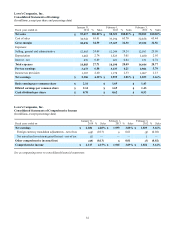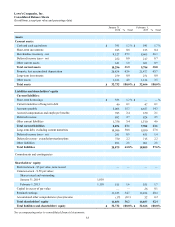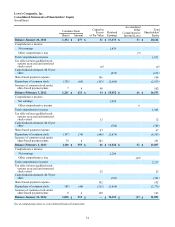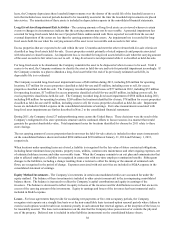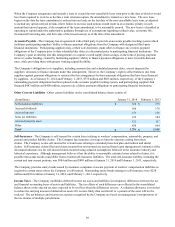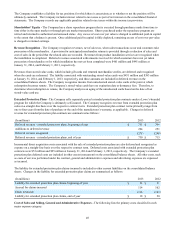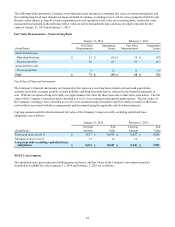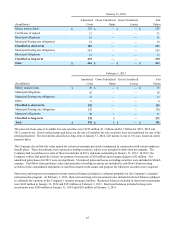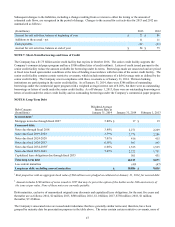Lowe's 2013 Annual Report Download - page 47
Download and view the complete annual report
Please find page 47 of the 2013 Lowe's annual report below. You can navigate through the pages in the report by either clicking on the pages listed below, or by using the keyword search tool below to find specific information within the annual report.
39
When the Company renegotiates and amends a lease to extend the non-cancellable lease term prior to the date at which it would
have been required to exercise or decline a term extension option, the amendment is treated as a new lease. The new lease
begins on the date the lease amendment is entered into and ends on the last date of the non-cancellable lease term, as adjusted
to include any option renewal periods where failure to exercise such options would result in an economic penalty in such
amount that renewal appears, at the inception of the lease amendment, to be reasonably assured. The new lease is classified as
operating or capital under the authoritative guidance through use of assumptions regarding residual value, economic life,
incremental borrowing rate, and fair value of the leased asset(s) as of the date of the amendment.
Accounts Payable - The Company has an agreement with a third party to provide an accounts payable tracking system which
facilitates participating suppliers’ ability to finance payment obligations from the Company with designated third-party
financial institutions. Participating suppliers may, at their sole discretion, make offers to finance one or more payment
obligations of the Company prior to their scheduled due dates at a discounted price to participating financial institutions. The
Company’s goal in entering into this arrangement is to capture overall supply chain savings, in the form of pricing, payment
terms or vendor funding, created by facilitating suppliers’ ability to finance payment obligations at more favorable discount
rates, while providing them with greater working capital flexibility.
The Company’s obligations to its suppliers, including amounts due and scheduled payment dates, are not impacted by
suppliers’ decisions to finance amounts under this arrangement. However, the Company’s right to offset balances due from
suppliers against payment obligations is restricted by this arrangement for those payment obligations that have been financed
by suppliers. As of January 31, 2014 and February 1, 2013, $735 million and $665 million, respectively, of the Company’s
outstanding payment obligations had been placed on the accounts payable tracking system, and participating suppliers had
financed $443 million and $400 million, respectively, of those payment obligations to participating financial institutions.
Other Current Liabilities - Other current liabilities on the consolidated balance sheets consist of:
(In millions)
January 31, 2014
February 1, 2013
Self-insurance liabilities
$
324
$
316
Accrued dividends
186
178
Accrued interest
153
136
Sales tax liabilities
122
104
Accrued property taxes
121
112
Other
850
664
Total
$
1,756
$
1,510
Self-Insurance - The Company is self-insured for certain losses relating to workers’ compensation, automobile, property, and
general and product liability claims. The Company has insurance coverage to limit the exposure arising from these
claims. The Company is also self-insured for certain losses relating to extended protection plan and medical and dental
claims. Self-insurance claims filed and claims incurred but not reported are accrued based upon management’s estimates of the
discounted ultimate cost for self-insured claims incurred using actuarial assumptions followed in the insurance industry and
historical experience. Although management believes it has the ability to reasonably estimate losses related to claims, it is
possible that actual results could differ from recorded self-insurance liabilities. The total self-insurance liability, including the
current and non-current portions, was $904 million and $899 million at January 31, 2014 and February 1, 2013, respectively.
The Company provides surety bonds issued by insurance companies to secure payment of workers’ compensation liabilities as
required in certain states where the Company is self-insured. Outstanding surety bonds relating to self-insurance were $228
million and $216 million at January 31, 2014, and February 1, 2013, respectively.
Income Taxes - The Company establishes deferred income tax assets and liabilities for temporary differences between the tax
and financial accounting bases of assets and liabilities. The tax effects of such differences are reflected in the consolidated
balance sheets at the enacted tax rates expected to be in effect when the differences reverse. A valuation allowance is recorded
to reduce the carrying amount of deferred tax assets if it is more likely than not that all or a portion of the asset will not be
realized. The tax balances and income tax expense recognized by the Company are based on management’s interpretation of
the tax statutes of multiple jurisdictions.





